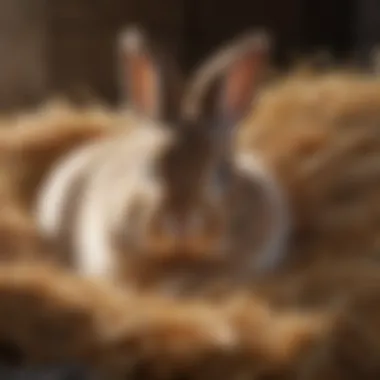Fluffy Bunnies: Characteristics, Care, and Companionship


Intro
Understanding fluffy bunnies is an essential first step for anyone considering bringing one into their home. These creatures are more than just cute pets; they have distinct characteristics, needs, and behaviors that must be acknowledged for proper care. This guide will explore various aspects of fluffy bunnies, aiming to provide insightful information for both current and prospective rabbit owners.
Understanding Your Pet
Fluffy bunnies exhibit a range of behaviors and traits that define them as a species. Recognizing these unique elements is crucial for developing a strong bond and ensuring their well-being.
Pet Behavior Basics
Most bunnies are social animals. They thrive on interaction with both humans and other rabbits. Communication includes body language and vocalizations. For example, a happy bunny may pounce or binky, while thumping often indicates distress or discomfort. Understanding these behaviors can enhance your ability to connect with them.
Common Breed Characteristics
Different bunny breeds exhibit unique physical and behavioral traits. Some popular breeds include:
- Holland Lop: Known for its floppy ears and friendly personality.
- Netherland Dwarf: Small in size, often playful and curious.
- English Angora: Recognized for its long, fluffy fur and gentle demeanor.
Being aware of these characteristics helps new owners to choose a breed that fits their lifestyle and preferences.
Species-Specific Needs
Bunnies have specific needs that vary from other pets. They require a spacious living environment, plenty of hay, and social interaction. Additionally, they need to chew on safe objects to maintain their dental health. Understanding these needs ensures a happy and healthy life for your bunny.
Pet Care and Maintenance
Caring for fluffy bunnies encompasses various responsibilities. A comprehensive approach to their care helps in creating a supportive environment.
Feeding Guidelines
A balanced diet is crucial for bunnies. They mainly eat hay, fresh vegetables, and a limited amount of pellets. Some recommended vegetables include:
- Romaine Lettuce: Great source of moisture.
- Kale: High in calcium, but should be given in moderation.
- Carrots: Treats in small quantities due to sugar content.
Grooming Essentials
Regular grooming is important, especially for long-haired breeds. Brushing helps prevent matting and reduces shedding. Additionally, nail trimming is necessary to avoid overgrowth and discomfort.
Hygiene Practices
Maintaining cleanliness is vital. Regularly clean their litter box and living area to prevent odors and promote health. A clean environment reduces stress and supports the overall well-being of your rabbit.
Training and Development
Training your bunny can improve its behavior and strengthen your bond. Basic training involves patience and positive reinforcement.
Basic Commands and Skills
Teaching simple commands like “come” or “stay” can be useful. Rewarding with treats helps in retaining learned behaviors.
Behavioral Training Techniques
Utilizing clicker training can be effective for bunnies. This method associates sounds with rewards, making it a positive experience for them.
Addressing Common Behavior Issues
Common issues may include chewing on furniture or litter box problems. Redirecting their energy to chew toys or designated areas can help mitigate these behaviors.
Health and Wellness
Routine health care is vital for fluffy bunnies. Regular check-ups can catch potential issues early.
Routine Vet Check-ups
Schedule annual vet check-ups to monitor their health status. This is also a good time to discuss any concerns with your vet.
Vaccination Needs
Vaccines play a critical role in preventing diseases. Consult your veterinarian about recommended vaccinations for your specific breed.


Recognizing Signs of Illness
Awareness of a bunny's normal behavior helps in identifying illness. Signs such as lethargy, loss of appetite, or abnormal droppings require immediate attention.
Enrichment and Activities
Enriching your bunny’s environment fosters physical and mental health. Engaging them in stimulating activities is key.
Indoor vs.
Outdoor Activities
Regardless of the space limitations, bunnies benefit from playtime. Indoor play can involve tunnels or mini obstacle courses made from safe materials while outdoor activity under supervision allows for exploring a new environment.
Interactive Toys and Games
Providing toys that encourage natural behaviors, such as chewing or digging, can keep them occupied and happy. Options include:
- Wooden chew toys: Aid in dental health.
- Cardboard boxes: Safe for chewing and hiding.
Socialization Opportunities
Socializing your bunny with gentle handling and regular interaction enhances their confidence. Allowing them to meet other rabbits can also support their social needs.
Proper understanding of fluffy bunnies leads to a deeper connection and a better environment for them, benefiting both pet and owner.
Through consideration of these key topics, individuals can create a fulfilling companionship with their fluffy friend, ensuring a life of happiness and health.
Preface to Fluffy Bunnies
The topic of fluffy bunnies holds a significant place for pet owners and animal lovers. Understanding these creatures is essential, not only for the joy they bring but also for the responsibilities involved in their care. Fluffy bunnies have unique traits that make them appealing pets, yet they require specific environments and dietary needs to thrive. By gaining insight into their behaviors, breeds, and care necessities, prospective and current bunny owners can ensure they provide a nurturing and supportive habitat.
The Appeal of Fluffy Bunnies
Fluffy bunnies have an undeniable charm that captivates many. Their soft fur, gentle demeanor, and playful nature contribute to their attractiveness as pets. Moreover, bunnies can be engaging companions. Their ability to learn and express individual personalities enhances their appeal.
As companions, bunnies are often seen as low-maintenance pets compared to dogs or cats. They tend to be quieter and can adapt well to indoor living. However, this perceived ease should not overshadow the fact that they are sentient beings with emotional and social needs. Understanding their appeal goes beyond their appearance; it encompasses the depth of the relationship one can build with them.
The joy they bring extends to small interactions, such as when they hop around or nuzzle for attention. These actions can create a bond between the bunny and its owner. Also, bunnies can be quite amusing to observe, each displaying unique habits and quirks. Such traits transform them from merely pets to cherished members of the family.
Understanding Bunny Breeds
Diving into the world of bunnies requires an understanding of the different breeds available. Each breed has its own set of characteristics, including size, fur type, and genetic tendencies. Recognizing these distinctions is crucial for potential owners. Some breeds might be more suitable for families with children, while others have specific care requirements, making it essential to match the breed to the owner’s lifestyle.
For example, the Netherland Dwarf bunny is a small breed that showcases a playful character. On the other hand, the Flemish Giant is larger and often more laid-back, requiring ample space for proper exercise and care. Recognizing the needs of different breeds helps ensure a successful and enriching relationship with the bunny.
In summary, understanding bunny breeds is not merely an academic exercise. It helps prospective owners make informed choices about which breed will fit best with their living situation and lifestyle.
“Choosing the right breed can significantly impact the experience of owning a bunny, influencing everything from behavior to care needs.”
Physical Characteristics of Fluffy Bunnies
Physical characteristics form the foundation of understanding fluffy bunnies. These characteristics influence not only their aesthetics but also their health and care needs. Knowing the specific traits of different breeds aids potential owners in making informed decisions, ensuring that the chosen bunny fits well within their home. Each variety presents unique grooming needs, personality traits, and dietary requirements that can affect the overall care experience. Thus, insight into these characteristics is vital not only for appreciation but also for promoting the well-being of these animals.
Coat Types and Colors
Bunnies boast a delightful variety of coat types and colors. This diversity is not merely for visual appeal; it also can indicate specific grooming needs and health factors. The coat can be categorized mainly into three types: short-haired, medium-haired, and long-haired. Each type has its own characteristics:
- Short-haired coats: These require minimal grooming, making them suitable for busy owners. Breeds like the American and Dutch fall into this category.
- Medium-haired coats: These may require regular brushing to prevent matting, as seen in breeds like the Holland Lop.
- Long-haired coats: Breeds such as the Angora need meticulous care. Regular brushing is crucial to avoid tangles and maintain coat health.
Color variations range from solid shades to intricate patterns. Some popular colors include black, white, brown, and mixed patterns like agouti and broken. These colors often play a role in breed recognition and may influence owners' choices. The color of the fur does not significantly affect health but can enhance the appeal of these bunnies for potential owners.
Size Variations Among Breeds
Bunny size greatly varies among breeds, making this an essential aspect for potential owners to consider. Understanding these size differences helps in choosing the right bunny that fits the owner’s lifestyle and living situation.
- Small breeds: Breeds such as the Netherland Dwarf typically weigh between 1.5 to 3.5 pounds. Their compact size makes them perfect for smaller homes or apartments.
- Medium breeds: Examples include the Mini Rex, ranging from 3.5 to 8 pounds. They offer a good balance, being manageable yet providing more presence.
- Large breeds: Breeds like the Flemish Giant can weigh over 14 pounds. While they require more space and resources, their gentle disposition can make them wonderful companions.
Recognizing the size of a bunny impacts not only the space requirement in a home but also considerations around diet and care routines. Larger breeds generally need more food and space for exercise, while smaller breeds may be more suited for families with young children. Overall, understanding size variations is crucial in ensuring a proper match between bunnies and their potential owners.


Behavioral Traits and Social Needs
The examination of behavioral traits and social needs is crucial in understanding fluffy bunnies. Bunnies are not simple pets; they possess complex personalities and require emotional support. Recognizing their behavioral patterns aids in creating a harmonious environment. It is essential for potential owners to grasp how bunnies act and interact with their surroundings. This knowledge leads to better quality of life for both the bunny and its owner.
Understanding Bunny Behavior
Buny behavior can be intricate. Observing how a bunny reacts to various stimuli can provide insights into its well-being. Bunnies often exhibit specific behaviors that reveal their emotional states. For instance, when a bunny thumps its hind legs, it may signal fear or caution. Similarly, flopping down on their sides is usually a sign of contentment or relaxation.
Understanding these signals is important for building trust. Bunnies are prey animals, and their instincts drive them to be cautious. Owners should approach their bunnies gently and allow them to explore at their own pace. Positive reinforcement techniques, such as offering treats, can encourage good behavior.
In addition to individual behavior, each breed may exhibit unique traits. For example, Holland Lop bunnies tend to be more social compared to other breeds. Learning these distinctions helps owners cater to their bunnies' specific needs.
The Importance of Social Interaction
Social interaction plays a significant role in a bunny's life. Bunnies are social creatures and thrive in companionship. They often form strong bonds with their human families and even other pets. Regular interaction minimizes feelings of loneliness, which can lead to behavioral issues such as chewing or excessive digging.
Owners should engage with their bunnies daily. Simple activities, like gentle petting or playing with toys, can greatly enhance their emotional health. For families with children, teaching kids the right way to interact with bunnies is essential. This helps prevent unintentional stress on the animal and promotes a respectful relationship.
In multi-bunny households, observing hierarchies and bonding behaviors is vital. Bunnies often groom each other as a sign of affection. Owners should monitor these interactions to ensure harmony within the group.
Key Point: Understanding and catering to a bunny's social needs is essential for its happiness. Lack of interaction can lead to stress and behavioral problems.
Overall, recognizing and nurturing these social dynamics leads to happier and healthier bunnies.
Dietary Requirements
Understanding the dietary requirements of fluffy bunnies is crucial to ensuring their health and well-being. Proper nutrition plays a fundamental role in maintaining their physical health, promoting behavior stability, and preventing common health issues. As prey animals, rabbits have specific needs that differ significantly from those of cats or dogs. A well-balanced diet can greatly influence their liveliness and longevity.
Essential Nutrients for Health
Bunnies require a mixture of nutrients to thrive. The primary components of a rabbit's diet include hay, fresh vegetables, and pellets.
- Hay: High-quality grass hay, such as timothy or orchard grass, should make up the bulk of a rabbit's diet. It is rich in fiber, which is essential for healthy digestion and helps keep their teeth worn down.
- Fresh Vegetables: Leafy greens like romaine lettuce, kale, and parsley are excellent for bunnies. They provide hydration, nutrients, and variety. It is important to introduce new vegetables gradually to avoid digestive upset.
- Pellets: While pellets are a part of the diet, they should not dominate it. Choose a pellet type that is high in fiber and low in protein. Look for brands that do not contain added sugars or seeds, as these can be unhealthy for rabbits.
Additionally, calcium and phosphorus are vital for bone health. It's important to strike a balance since excessive calcium can lead to urinary issues.
Proper nutrition is key to a rabbit's overall health, impacting their behavior and life expectancy.
Recommended Foods and Treats
In addition to their daily diet, bunnies enjoy a variety of healthy treats that can enrich their eating experience. When selecting treats, moderation is key to avoid obesity and digestive problems.
- Fruits: Small amounts of fruits like strawberries, banana slices, or apple pieces can serve as treats. However, limit these to about one to two tablespoons daily.
- Edible Flowers: Flowers such as dandelions and nasturtiums are safe and can provide additional nutrients. Ensure they are pesticide-free before offering them.
- Herbs: Fresh herbs like basil, cilantro, or mint are not only safe but loved by many bunnies. They can serve as a flavor-enhanced alternative to standard greens.
Foods to Avoid include:
- Iceberg lettuce (can cause diarrhea)
- Potatoes (toxic)
- Chocolate (toxic)
- Processed human foods
When introducing any new food, it is advisable to do so incrementally. Observing your bunny's reaction can help identify any sensitivities they may have. Also, ensuring access to fresh water always keeps them hydrated.
By understanding and applying these dietary principles, rabbit owners can create a nourishing environment that supports the health and happiness of their furry companions.
Creating the Ideal Living Environment
Creating an optimal living environment for fluffy bunnies is essential for their health, happiness, and overall well-being. Bunnies are naturally curious creatures and they require a space that caters to their instinctual behaviors. This section explores the key elements that comprise a suitable habitat for rabbits, emphasizing the benefits of thoughtful design and consideration.
Cage Specifications and Size
The cage is not just a place for a bunny to sleep; it is their safe haven. The size of the cage is crucial. A larger cage provides room for the rabbit to move, play, and explore. It is generally recommended that the cage should be at least four times the size of the rabbit when fully stretched out. For example, if you have a medium-sized rabbit, a cage that measures around 36 inches long would be a minimal requirement.
Material also matters. Choose a sturdy cage made of wire or metal that allows for ventilation and visibility, while a solid bottom is mandatory for comfort. Avoid flimsy materials that can easily wear out. Additionally, ensure that the bar spacing is no more than one inch to prevent the bunny from escaping or getting stuck.
- Suitable Cage Types:
- Indoor cages: enclosed but spacious, these are ideal for indoor settings.
- Outdoor hutches: must be secure from predators and weather.
- Pens or play areas: additional space for exercise beyond their cage.
Bunny-proofing Your Home
Bunnies are inquisitive and will chew on anything within reach. Therefore, it is critical to bunny-proof your home. This means removing hazards and creating a safe environment.


Begin by identifying potential risks: electric cords, toxic plants, and anything small that could be swallowed. Use cord concealers or protective coverings to keep harmful elements out of reach.
Moreover, consider the following steps to effectively bunny-proof:
- Block access to dangerous areas: Use baby gates to restrict access to rooms that are unsafe for rabbits.
- Remove toxic plants: Common houseplants such as lilies and ivy can be harmful.
- Provide alternatives: Offer safe chew toys to satisfy their natural instincts while keeping your furniture protected.
Bunnies thrive in a secure environment, which helps reduce stress and promote playful behavior.
In summation, establishing a proper living environment requires attention to cage specifications and home safety. A secure cage that allows ample space and a home free from hazards will contribute significantly to the well-being of fluffy bunnies.
Health Considerations
Health considerations are crucial for any pet owner. For fluffy bunnies, understanding their health needs is necassary to ensure a long and happy life. This section covers common health issues and the importance of routine veterinary care.
Common Health Issues
Fluffy bunnies can be prone to various health concerns. Here are some of the most common issues that may arise:
- Dental Problems: Rabbits' teeth grow continuously. If they do not wear down naturally through chewing, they can cause pain and infections.
- Gastrointestinal Stasis: This condition occurs when the digestive system slows or stops, which can lead to serious health complications.
- Obesity: Overweight rabbits face risks like heart disease. Proper diet and exercise are essential to prevent obesity.
- Skin Issues: These can include fungal infections or parasite infestations, leading to discomfort and requiring veterinary attention.
- Respiratory Problems: Bunnies can be sensitive to environmental changes. Dusty bedding or drafty places can affect their lungs.
It is essential for owners to be aware of these potential issues. Regular observations and prompt medical attention can greatly improve the outcome for affected bunnies.
Important: Pay attention to any changes in your bunny's behavior, appetite, or litter box habits. These can indicate health issues.
Routine Veterinary Care
Routine veterinary care is key for maintaining the health of fluffy bunnies. Here are some important aspects to consider:
- Regular Check-Ups: Schedule annual veterinary visits for your bunny to catch any health issues early. This is critical for preventing serious conditions.
- Vaccinations: Consult with your veterinarian about necessary vaccinations. This can protect your bunny from certain viral diseases.
- Spaying/Neutering: These procedures are recommended, as they can prevent certain health issues and unwanted behaviors.
- Dental Care: Regular dental check-ups are essential. The veterinarian can identify overgrown teeth and provide appropriate care.
- Parasite Prevention: Discuss flea and tick prevention methods with your vet. This will help in avoiding infestations.
Taking these steps ensures your bunny lives a healthy life. You become a responsible pet owner by integrating routine veterinary care into your bunny's life. This will help to promote overall well-being for your companion.
Training and Behavior Management
Training and behavior management are crucial components for anyone looking to raise fluffy bunnies. Understanding these elements can significantly enhance the bond between the owner and the rabbit. Effective training not only reinforces good behavior but also helps mitigate common behavioral issues. A well-trained bunny is often happier and more comfortable in its environment, leading to a more harmonious household.
Basic Training Techniques
Training a bunny may seem challenging at first, but it is essential for their well-being. One of the most effective ways to train a bunny is through positive reinforcement. This method involves rewarding desirable behaviors rather than punishing unwanted ones.
Techniques to Consider:
- Clicker Training: This technique pairs a sound (like a click) with a treat, helping the bunny associate the sound with positive outcomes.
- Treat Rewards: Use small, healthy treats to encourage desired behaviors, like hopping into a litter box or following you.
- Luring: You can guide your bunny using a treat to teach them commands like “come” or “sit.”
To successfully train your bunny, short training sessions are recommended. Around five to ten minutes per session is ideal. Repetition is key, so be patient.
Addressing Behavioral Issues
Despite their charming nature, bunnies can exhibit various behavioral problems. Understanding these issues is vital for maintaining a peaceful home. Common problems include chewing on furniture, litter box mistakes, or signs of anxiety.
Common Behavioral Issues Include:
- Destructive Chewing: Bunnies naturally chew, so providing safe chew toys and bunny-proofing your home is necessary.
- Litter Box Problems: To mitigate this, ensure the litter box is cleaned regularly and placed in a quiet location.
- Fear and Anxiety: Proper socialization is important. Spend time handling and interacting with your bunny in a calm environment to help reduce anxiety.
Remember, addressing behavioral issues requires understanding and patience. Negative reinforcement can often worsen behavior, so focus on positive strategies.
By implementing these methods, rabbit owners can create a more enjoyable living situation for both themselves and their furry companions. Such training and behavior management ultimately foster a respectful, loving relationship. Owners can find additional resources and community support through platforms like reddit.com where discussions about bunny care are prevalent.
Closure and Further Reading
The conclusion of this article serves as both a summarization of important aspects related to fluffy bunnies and a launchpad for further exploration by readers. Understanding fluffy bunnies’ characteristics and care requirements is essential for responsible pet ownership. This article has aimed to equip potential and current bunny owners with the necessary information to create a nurturing environment for their pets. As caretakers, it is vital to grasp the unique traits of rabbits and the responsibilities involved in their care.
Recap of Key Points
Fluffy bunnies possess a range of distinct traits that highlight their uniqueness as pets. Here is a recap of the key points discussed:
- Physical Characteristics: Bunnies vary in size and coat types, presenting a broad spectrum of options for owners.
- Behavioral Traits: Understanding bunny behavior is crucial to meeting their social needs. They thrive on interaction with both humans and other rabbits.
- Dietary Needs: A balanced diet is vital for a bunny's health. Knowing what to feed them can significantly increase their well-being.
- Living Environment: Providing an ideal living space, free from hazards, ensures that bunnies feel safe and happy.
- Health Considerations: Regular veterinary care and awareness of common health issues help in maintaining rabbits' health.
- Training Techniques: Addressing behavioral concerns through training promotes a harmonious relationship between bunnies and their owners.
These points serve as the foundation for a positive relationship with fluffy bunnies, underscoring the importance of informed decision-making in pet care.
Additional Resources for Bunny Owners
For those seeking to expand their knowledge and further support their furry companions, there are several resources available:
- Wikipedia: A rich source for general information about rabbits and their breeds. Wikipedia
- Britannica: Comprehensive articles that provide insights into the biology and care of rabbits. Britannica
- Reddit: A community of bunny owners sharing experiences and advice about caring for their pets. Reddit
- Facebook Groups: Engaging with communities dedicated to rabbit care offers real-time support and knowledge. Search for relevant groups on Facebook.
Arming oneself with information and resources leads to enhanced pet care practices. Responsible ownership fosters health and happiness for furry companions.







